Physical Address
304 North Cardinal St.
Dorchester Center, MA 02124
Hand and wrist pain and restricted movement are common disabling complaints that may be caused by a broad spectrum of soft tissue disorders. These injuries may be the result of a single incident, such as falling on an outstretched hand, or the result of repeated overuse, such as in ongoing athletic or occupational activities.
Clinical diagnosis and management is challenging. Findings are usually nonspecific, and similar ones can be found among the different pathologic conditions in the wrist and hand. Outcome may be improved by timely implementation of various treatment options. Therefore, accurate diagnosis is a key element of a successful treatment plan, and recent advances in imaging have led to an improved ability to establish a noninvasive diagnosis.
In this chapter we review the pathology, clinical and radiologic manifestations, differential diagnosis, and therapeutic strategies for soft tissue injuries of the hand and wrist, with emphasis on MRI and MR arthrography.
Ulnar wrist pain has often been equated with low back pain because of its insidious onset, vague and chronic nature, intermittent symptoms, and the frustration that it induces in patients. Ulnar wrist pain may frequently be caused by a group of pathologic bone or soft tissue disorders, including triangular fibrocartilage complex (TFCC) tears, distal radioulnar joint (DRUJ) arthritis and instability, lunotriquetral ligament disruption, Kienböck disease, pisotriquetral arthritis, extensor carpi ulnaris lesions, and ulnar-sided wrist impaction syndromes.
Ulnar-sided wrist impaction syndromes constitute a broad spectrum of lesions that result from repetitive or acute forced impaction between the distal ulna and ulnar carpus or distal radius and surrounding soft tissues resulting in bone or soft tissue lesions. Ulnar-sided wrist impaction syndromes can be divided into five main categories ( Table 18-1 ). The most common type, ulnar impaction syndrome, is discussed in Chapter 15 .
| 1 | Ulnar impaction syndrome |
| 2 | Ulnar impingement syndrome |
| 3 | Ulnar styloid impaction syndrome |
| 4 | Hamatolunate impaction syndrome |
| 5 | Combined ulnar and ulnar styloid impaction syndrome |
Conventional radiographic findings of anatomic variants or pathologic conditions of the ulnar wrist can suggest the diagnosis of a given ulnar-sided impaction syndrome. However, significant disease and incapacitating pain may be present despite minimal evidence from conventional radiography. MRI and MR arthrography allow earlier detection of the bone and soft tissue lesions present in the various ulnar-sided wrist impaction syndromes and may offer different treatment alternatives.
Ulnar impingement syndrome is a painful condition caused by a shortened distal ulna that impinges on the distal radius proximal to the sigmoid notch. The terms ulnar impingement and ulnar impaction are often used interchangeably, but these syndromes are not only distinct but also mutually exclusive.
A markedly shortened distal ulna most frequently results from any of the surgical procedures that involve resection of the distal ulna secondary to prior wrist trauma, rheumatoid arthritis, or correction of Madelung deformity. Ulna head resection (Bowers), fusion or resection of the distal ulna (Sauvé-Kapandji), hemiresection interposition arthroplasty (Watson), and several modifications of these procedures are some of the surgical techniques that may be complicated by the development of ulnar impingement ( Fig. 18-1A ). Less commonly, ulnar impingement may be present in de novo cases of ulnar-negative variance or premature fusion of the distal ulna secondary to epiphysiolysis (see Fig. 18-1B and eFig. 18-1 ).
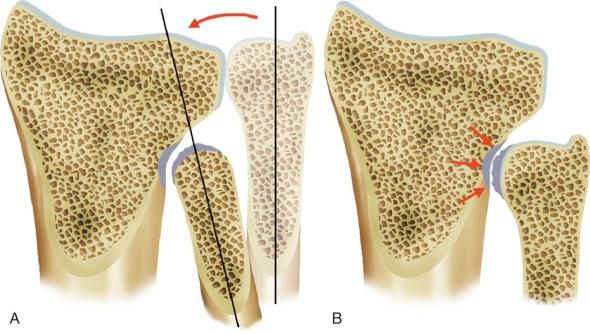
Shortening of the distal ulna causes approximation of the distal radial and ulnar ends due to the contraction of the extensor pollicis brevis, abductor pollicis longus, and pronator quadratus muscles and the effect of the interosseous membrane, with loss of the buttress of the DRUJ. This is known as radioulnar convergence and is rarely symptomatic. With chronic distal radioulnar contact, it might become symptomatic and is named ulnar impingement.
Clinical manifestations of ulnar impingement syndrome can be similar to those of ulnar impaction syndrome and are not specific. Typically, patients experience pain on pronation and supination of the forearm and weakness on lifting even relatively light objects. Compression of the DRUJ on forearm rotation increases the symptoms or produces grating in affected patients and is very useful in identifying incongruity of the DRUJ.
Ulnar impingement can produce erosive and proliferative cortical changes along the ulnar margin of the distal radius proximal to the sigmoid notch level that appear as scalloping and bone hypertrophy on conventional radiographs ( Fig. 18-2A ). By the time such changes are seen, the condition has been present for many years.
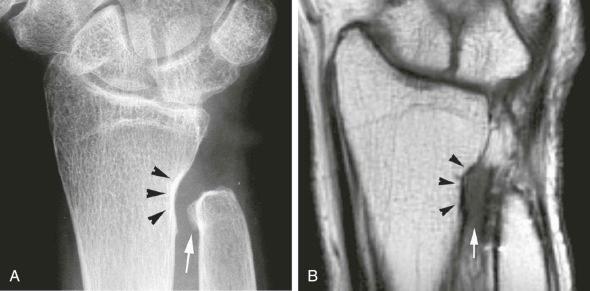
The stress-loaded radiologic view described by Lees and Scheker will confirm the diagnosis before erosive changes are visible showing the radioulnar convergence. A stress-loaded projection is performed by asking the patient to grip a cylindrical object 2 cm in diameter as firmly as possible with the shoulder adducted, the elbow flexed to 90 degrees, and the forearm in the position of neutral rotation. The radiograph is then taken with the beam aligned in the coronal plane with respect to the anatomic position. CT allows the evaluation of scalloping or proliferative changes along the ulnar margin of the distal radius proximal to the sigmoid notch level.
Isotope bone scintigraphy is rarely necessary for the evaluation of this disorder. Bone scintigraphy may show increased uptake about the ulnar side of the distal radius and ulnar head.
Magnetic resonance imaging is helpful for confirming the diagnosis before erosive changes are visible in conventional radiographs, showing subtle sclerosis and bone edema at the corresponding level of the radius and on the distal ulna together with fluid effusion on the radioulnar joint (see Fig. 18-2B ; see also eFig. 18-3 ). In advanced stages, scalloping and sclerosis along the ulnar margin of the distal radius cephalad to the sigmoid notch, sclerosis in the ulnar seat, and bony spurs or osteophytes on both margins are clearly visualized on MR images.
Diagnosis of ulnar impingement remains difficult and often delayed because symptoms and clinical findings are usually nonspecific and similar among the various pathologic conditions in the ulnar-sided wrist.
The current surgical options include the use of ulnar head prostheses that stabilize the ulnar head stump and correct convergence instability. Several are available (e.g., Shecker, Herbert, Avanta, Eclypse prostheses). Early reported results are good, but follow-up loosening, stem breakage, and “sinking” of the prosthesis into the radius have been acknowledged. Prevention (i.e., avoidance of ulnar head resection) currently seems to be the best available option.
Ulnar styloid impaction syndrome is an underrecognized etiology of ulnar wrist pain caused by repetitive impaction between the ulnar styloid and the triquetrum bone and the surrounding soft tissues. It appears more often in wrists with ulnar-negative variance and results from repetitive or acute forced ulnar deviation and dorsiflexion of the wrist.
Anatomic variations are common in the ulnar wrist, including supernumerary ossicles and morphologic variations of the ulnar styloid. The ulnar styloid process is a continuation of the prominent subcutaneous ridge of the shaft of the ulna, which projects distally toward the triquetral bone for a variable distance (3 to 6 mm) and with medial angulation exceeding 15 degrees. Garcia-Elias has developed a method of assessing the relative size of the ulnar styloid called the ulnar styloid process index (USPI). An excessively long ulnar styloid has a USPI greater than 0.21 ± 0.07 or an overall length greater than 6 mm, predisposing to an impaction syndrome ( Fig. 18-3 ).
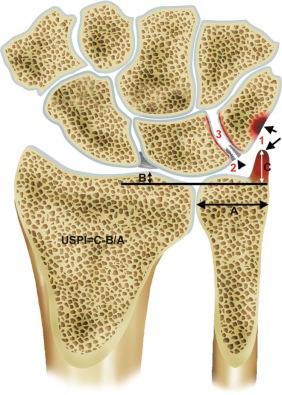
Ulnar styloid impaction syndromes can be classified into four subtypes based on different morphologic or pathologic conditions of the ulnar styloid implicated in the etiology of this clinical entity. Morphologic variations include an elongated, radially deviated, or enlarged ulnar styloid process, and pathologic conditions include nonunion, malunion, or hypertrophy of the ulnar styloid process ( Fig. 18-4 ; Table 18-2 ).
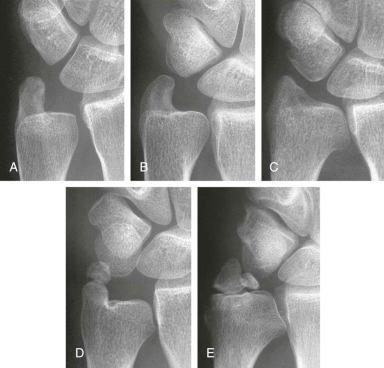
| 1 | Ulnar styloid impaction syndrome secondary to elongated ulnar styloid |
| 2 | Ulnar styloid impaction syndrome secondary to radially deviated ulnar styloid (parrot-beaked) |
| 3 | Ulnar styloid impaction syndrome secondary to enlarged ulnar styloid |
| 4 | Ulnar styloid impaction syndrome secondary to ulnar styloid nonunion |
| 4A | With a stable distal radioulnar joint. Nonunion of the ulnar styloid with intact triangular fibrocartilage complex ulnar attachment |
| 4B | With distal radioulnar joint instability. Nonunion of the ulnar styloid with avulsion of the ulnar attachment of the triangular fibrocartilage complex |
An elongated ulnar styloid is the most common variant implicated in the development of ulnar styloid impaction syndrome. Another anatomic variant is an ulnar styloid process curved in the volar and radial directions, giving a “parrot-beaked” appearance, which significantly reduces the styloid-carpal distance. A pathologic sequence of events has been postulated in patients with ulnar styloid impaction syndrome with a long or radially deviated ulnar styloid.
Single-event or repetitive impaction between the tip of the ulnar styloid process and the triquetral bone results in contusion, which leads to chondromalacia of the opposing articular surfaces, synovitis, and pain. If a single-event trauma is forceful enough, fracture of the dorsal triquetral bone (chip fracture) may occur. Impaction over a long period of time can lead to lunotriquetral instability (see Fig. 18-3 ).
An enlarged ulnar styloid can be an anatomic variant or secondary to malunion of avulsion fracture at the fovea of the ulna. This ulnar styloid morphologic variation reduces the ulnar joint space, resulting in repetitive impaction between the ulnar styloid and the ulnar aspect of the lunate bone and the radial aspect of the triquetral bone. TFCC wear or perforation is frequently present.
Ulnar styloid fractures occur commonly in association with distal radius fractures. Symptomatic nonunions of the ulnar styloid are probably underrecognized and/or underreported in the literature.
Two types of nonunion of the ulnar styloid have been classically described on an anatomic basis and have different treatments. Type 1 is defined as a nonunion associated with a stable DRUJ. It affects only the tip of the styloid and the TFCC remains intact because its major attachments are at the base of the styloid. Type 2 is defined as a nonunion associated with subluxation of the DRUJ. It is the result of an avulsion of the ulnar attachment of the TFCC (Palmer class IB lesion). Recent evidence has shown that this is an oversimplified subdivision, because although severely displaced basilar fractures of the ulnar styloid are more commonly associated with DRUJ instability, “chip” fractures can also be associated with instability if there is a concomitant TFCC injury.
Ulnar styloid nonunion may become symptomatic for different reasons. The nonunited fragment may act as an irritative loose body or abut the carpus. A malaligned fibrous nonunion may cause impingement of the extensor carpi ulnaris tendon sheath. The nonunion may also be symptomatic because of associated TFCC perforation or, as stated earlier, because of complete rupture of the ulnar attachments of the TFCC and hence an unstable DRUJ.
The diagnosis of ulnar styloid impaction syndrome is based primarily on the patient's clinical history and physical examination and is supported by radiographic evidence of morphologic variations or pathologic conditions of the ulnar styloid (see Fig. 18-4 ).
The ulnar styloid architecture measurements (ulnar styloid length, angle, and width) and ulnar variance should be recorded in the neutral posteroanterior view of the wrist. In advanced stages, plain radiographs may reveal degenerative changes in the ulnar styloid and the triquetrum bone.
Computed tomographic scans with 3D reconstructions allow an exquisite assessment of the osseous anatomic variants in the ulnar wrist that can be related to development of this clinical entity. CT is inaccurate for revealing early soft tissue and osseous changes associated with ulnar styloid impaction syndromes, such as chondromalacia, synovitis, and subchondral bone edema. In advanced stages, CT may reveal degenerative osseous changes in the ulnar styloid and the triquetrum bone, including subchondral sclerosis and cortical irregularities.
In patients with an ulnar styloid that is elongated or radially deviated, MRI may show chondromalacia on the tip of the ulnar styloid and dorsal aspect of the triquetrum bone ( Fig. 18-5 ). Secondary subchondral changes, including bone marrow edema, sclerosis, and cysts, in characteristic locations can be detected by MRI in patients without significant abnormalities on routine plain radiographs. The presence of synovitis and joint effusion in the ulnocarpal joint is also a common indirect sign of ulnar styloid impaction syndrome.
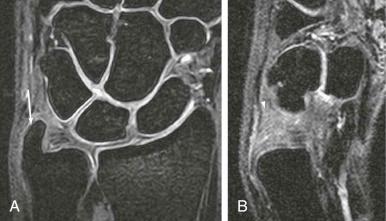
In patients with an enlarged ulnar styloid, the same findings can be seen in the ulnar aspect of the lunate, triquetrum, and ulnar styloid. MRI is helpful in the detection of degenerative fraying or tears of the TFCC, which are frequent findings in these patients.
In patients with ulnar styloid impaction syndrome secondary to nonunion of the ulnar styloid, MRI is an excellent modality for visualizing the integrity of the TFCC and its ulnar attachments, the presence of nonunited bone fragments, and the associated chondromalacia and subchondral bone changes of the carpus. Depending on the attachment of the TFCC, the stability of DRUJ will be determined. Tenosynovitis or tendinosis of the extensor carpi ulnaris secondary to an irritative loose body can also be detected by MRI.
MR arthrography is a useful tool in the preoperative evaluation of ulnar styloid impaction syndromes, allowing diagnosis of chondromalacia in the dorsal aspect of the triquetrum and ulnar styloid tip, accurate diagnosis of associated tears of the dorsocubital aspect of the TFCC, and detection of synovial thickening and synovitis in the dorsal capsular recess.
Arthroscopic findings may be divided into three stages. The early stage shows only synovitis in the dorsal capsular recess and dorsal aspect of the triquetrum. In stage II, the synovitis is marked on the dorsal capsular recess; there is denudement of the dorsal aspect of the triquetrum, and synovitis is evident in the vicinity of the midcarpal joint. In more advanced cases, the tip of the styloid can be seen perforating the TFCC, and the dorsal part of the triquetrum can be totally devoid of cartilage.
From clinical data, ulnar styloid impaction syndrome should be differentiated from other causes of ulnar-sided pain, including fundamentally other ulnar impaction syndromes, TFCC lesions, lunotriquetral instability, and a pathologic process of the extensor carpi ulnaris.
There is little room for conservative treatment for this disorder. Only in acute cases, triggered by trauma, does it seem reasonable to try conservative treatment (rest, splinting, and nonsteroidal anti-inflammatory drugs). Otherwise, the best approach is to assess the joint under arthroscopy, to débride synovitis in the dorsal capsule/dorsal triquetrum, and to remove the styloid. Although in some cases the styloid can be resected arthroscopically, in most cases it is better done through a 1.5-cm ulnar incision. The styloid is removed subperiosteally, taking care to preserve 2 to 3 mm of its more proximal base, so as not to interfere with the foveal attachment of the TFCC.
Hamatolunate impaction is an uncommon cause of ulnar-sided wrist pain secondary to chondromalacia of the proximal pole of the hamate bone in patients with lunate bones that have a medial additional articular facet on the distal surface for articulation with the hamate bone ( Fig. 18-6 ).
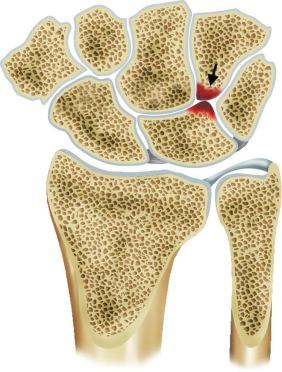
Viegas described two different anatomic variations of the lunate bone: type 1, in which the lunate does not have an articular facet with the proximal pole of the hamate, and type 2, in which an articulation exists between the lunate and hamate. Type 2 lunate bone is present in 57% to 73% of wrists.
The anatomic variation of type 2 lunate bone produces alteration of the normal uniform loading and focally altered mechanics when the hamate jumps over the extra facet during forced ulnar deviation. This leads to a higher incidence of cartilage erosion with exposed subchondral bone on the proximal pole of the hamate bone than in those without this articulation (type 1 lunate bone).
Patients experience pain in full ulnar deviation of the wrist, especially when combined with first holding the distal carpal row in forced supination.
The hamatolunate articulation is seen relatively frequently during arthroscopy of the midcarpal joint, but only about 40% of those articulations are evident radiologically. This facet is variable in size (from 1.2 to 12 mm) and may occupy between 10% and 50% of the distal aspect of the lunate. In the clinical setting of ulnar-sided wrist pain, the radiographic evidence of a type 2 lunate bone should raise the question of arthrosis at the proximal pole of the hamate as the most likely source of the complaint.
Computed tomography allows a precise evaluation of anatomy of the mediocarpal joint and the anatomic lunate variants described by Viegas. CT is not sensitive to the early changes of hamatolunate impaction syndrome, such as chondromalacia and subchondral edema in the proximal pole of the hamate bone. In more advanced disease, CT shows characteristic findings of sclerosis and subchondral cyst in the proximal pole of the hamate.
Magnetic resonance imaging has low sensitivity for early stages of chondromalacia but can detect bone edema ( Fig. 18-7 ), sclerosis, and subchondral cysts in the proximal pole of the hamate bone as secondary signs of chondromalacia and focal osteoarthritis. Midcarpal synovitis is a common indirect MR sign of hamatolunate impaction.
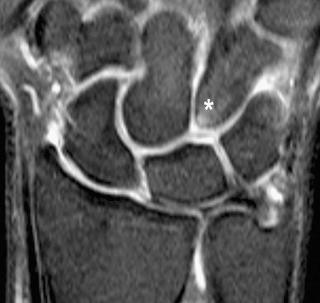
The loss of cartilage on the tip of the hamate body is common in the type 2 variant and in itself is a finding without any clinical implication. However, when it is accompanied by clinical symptoms and midcarpal synovitis, the arthroscopy is diagnostic.
Clinically, the differential diagnosis is extensive and includes the full spectrum of ulnar wrist pain.
Arthroscopic burring of the apex of the hamate bone through a midcarpal portal represents the state-of-the-art treatment for this condition because it relieves symptoms but does not adversely affect carpal mechanics.
Injuries to the intrinsic ligaments are frequently associated with extrinsic volar and dorsal ligament lesions and may often be a cause of chronic wrist pain and dysfunction. Intrinsic and extrinsic ligaments play an important role in wrist stability.
Carpal instability concept has evolved considerably during recent years. Although instability was traditionally considered synonymous with malalignment, not every alteration of carpal alignment is pathologic, and instability can be present without malalignment. Congenital hyperlaxity can be present with marked malalignment, is frequently asymptomatic, and does not usually require treatment. Some patients refer only to pain and a sensation of “giving way” when performing some specific task. Therefore, stability must be maintained statically and dynamically. In dynamic instability, malalignment occurs only under certain loads, whereas in static instability, it is permanent despite the load applied. A biomechanically normal wrist must be able to transfer loads and perform a whole range of movements. Instability, or “carpal dysfunction,” implies the loss of normal wrist ability to transfer loads without sudden changes of stress on the articular cartilage (normal kinetics) and the capacity to move throughout the normal range without sudden alterations of intercarpal alignment (normal kinematics).
Classically, four major types of carpal instability were recognized, always to be diagnosed by plain radiography: dorsiflexed intercalated segment instability (DISI) when the lunate is an intercalated segment between the distal row and the abnormally extended forearm; volarflexed intercalated segment instability (VISI) when the lunate appears abnormally flexed; ulnar translocation when the proximal row has an ulnar deviation relative to the radius; and dorsal translocation when the carpus is subluxed in a dorsal direction secondary to a malunited radial fracture.
Anatomy of the carpal ligaments is complex, with anatomic variations in ligament size and shape and confusing descriptions ( eFig. 18-2 ). Wrist ligaments can be divided into intracapsular or intraarticular, except for the transverse carpal ligament and the two distal connections of the pisiform to the hamate and the base of the fifth metacarpal, which are extracapsular. Intracapsular carpal ligaments connect individual carpal bones (“intrinsic ligaments”) or link carpal bones to the radius or ulna (“extrinsic ligaments”). Variation in the description of the volar and dorsal extrinsic ligaments is due to anatomic variation and because they consist of focal capsular thickening and are not discrete structures. The volar complex is stronger than the dorsal one and plays a predominant role in carpal stability. However, dorsal ligaments are more important for carpal instability and kinematics than previously thought.
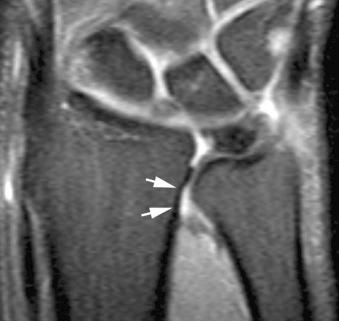
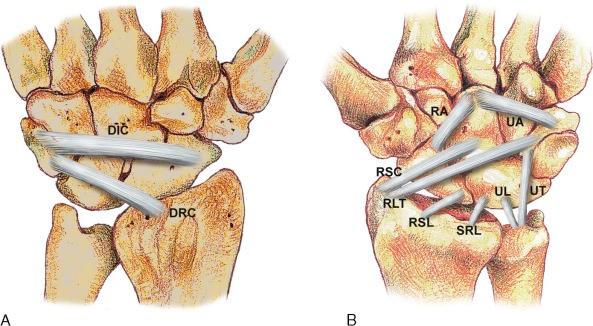
Volar extrinsic radiocarpal ligaments include the radioscaphocapitate, radiolunotriquetral or long radiolunate, radioscapholunate, and short radiolunate ligaments. Volar ulnocarpal ligaments comprise ulnolunate and ulnotriquetral ligaments; they originate at the volar edge of the TFCC and insert into the lunate and the triquetrum, respectively. The arcuate, or deltoid ligament, is a V-shaped volar intrinsic ligament with a capitotriquetral (ulnar) and a capitoscaphoid (radial) arm. The dorsal extrinsic radiocarpal ligament includes the dorsal radiotriquetral and dorsal intercarpal ligaments.
Intrinsic ligaments—scapholunate and lunotriquetral—join proximal carpal bones and separate them from the radiocarpal and midcarpal compartments.
Many different conditions such as trauma, inflammation, infection, tumor, or congenital disease may result in an unstable wrist. The traumatic mechanism of injury for most carpal dislocations is a fall on the outstretched hand, causing wrist extension, ulnar deviation, and intercarpal supination.
Mayfield's progressive perilunate instability describes a sequential pattern of four-stage ligamentous injury. It starts on the radial aspect of the wrist and extends through the perilunate ligaments to end at the ulnar side. Stage 1 consists of a tear of the volar extrinsic radioscaphocapitate ligament with elongation or partial tearing of the scapholunate ligament. Continuous loading leads to complete failure of the scapholunate joint, stage 2, followed by failure of the radioscaphocapitate ligament or an avulsion fracture of the radial styloid. Stage 3 consists of separation of the triquetrum from the lunate with associated injury to the radiolunotriquetral ligament and dorsal radiocarpal ligament disruption. Finally, in stage 4 the ultimate failure of the dorsal radiocarpal ligament with volar lunate dislocation occurs.
Carpal instability is classified into four major patterns (see Table 18-3 ): dissociative carpal instability (CID), nondissociative carpal instability (CIND), complex carpal instability (CIC), and adaptive carpal instability (CIA). CID implies injury to one of the major intrinsic ligaments, such as scapholunate and lunotriquetral dissociation or capitate-hamate axial disruptions. CIND connotes an injury to a major extrinsic ligament, with intact intrinsic ligaments such as occurs in radiocarpal instability or midcarpal instability. Not unusually, both CID and CIND may be found together, which is classified as CIC. Carpal instability not located within the wrist but proximal or distal to it is classified as adaptive carpal instability.
| 1 | Dissociative carpal instability (CID) |
| 2 | Nondissociative carpal instability (CIND) |
| 3 | Complex carpal instability (CIC) |
| 4 | Adaptive carpal instability (CIA) |
The most common types of carpal instability are scapholunate and lunotriquetral dissociation ( Table 18-3 ).
Routine radiographic examination when carpal instability is suspected should include six views: posteroanterior, lateral, radial and ulnar deviation, and flexion and extension.
Important information can be missed with poor-quality films. Posteroanterior radiographs should be made with the patient's shoulder abducted 90 degrees, elbow flexed 90 degrees, and forearm in neutral rotation. To obtain a true lateral view, the wrist must be adducted to the patient's side and be in neutral rotation. Dorsal surfaces of the metacarpals, radius, and ulna should be straight to demonstrate any possible alteration of the alignment of the carpal bones. Palmar surface of the pisiform should lie between and equidistant to palmar surfaces of the distal scaphoid tuberosity and the capitate head.
On a posteroanterior view, three normal carpal radiographic arcs (Gilula's lines) must be smoothly drawn, and the separation between the bones must be 2 mm or less (see eFig. 18-3 ). Any disruption of this arc indicates intercarpal derangement; overlap between carpal bones or cortices asymmetric with the contralateral wrist suggest carpal joint abnormality. A normal lunate exhibits a trapezoidal configuration; a triangular lunate implies that the lunate is tilted, but not necessarily dislocated. Lunate shape helps to differentiate whether it is flexed or extended; for example, there is a triangular shape in DISI but a moonlike configuration in VISI.
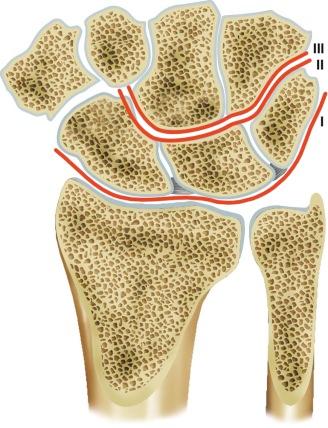
When the initial radiographic evaluation of a patient with a suspected carpal dysfunction does not confirm the diagnosis and clinical suspicion exists, additional views are recommended. Their purpose is to evaluate specific areas of tenderness and swelling and to clarify subtle changes seen in the routine views. In the literature, many projections have been suggested.
The following are the most commonly used: an anteroposterior (palm up) view with clenched fist; a posteroanterior (palm down) view with 10 degrees of tube angulation from the ulna toward the radius; an oblique view at 20 degrees pronation off the lateral position; an oblique view at 30 degrees supination off the lateral position; and a lateral view with the wrist radially deviated and carpal tunnel view.
Carpal malalignment has traditionally been measured on posteroanterior or lateral radiographs, with specific distances and angles. More frequently used angles—capitolunate, scapholunate, and radiolunate—are based on axes traced on lateral radiographs. The more commonly used distances, measured on a posteroanterior projection of the neutral-positioned wrist, are ulnar variance, carpal height ratio, capitate-radius index, and ulnar translocation ratio.
One must be aware of the normal wide ranges for these parameters, the low reproducibility, and the fact that small rotational positioning of the hand at the time of radiation exposure may result in substantial variation in angle determinations.
Fluoroscopic imaging is used occasionally to assist in the diagnosis of dynamic instability. Instability is assessed during active wrist motion and with provocative testing. Asynchronous motion between the wrist bones and interval gapping are indicative of a destabilizing injury.
In some instances, dynamic instabilities cannot be diagnosed with a motion series but require stressing a specific joint in different directions to see the abnormality. A fairly common technique for investigating midcarpal instabilities involves a dorsopalmar translation of the distal carpal row relative to the radius (“drawer test”). Less commonly used, yet productive in terms of discovering abnormal behavior of the radial column, are views of the wrist in maximal passive ulnar deviation.
Cineradiography or videotaping a fluoroscopic examination of the wrist provides considerable information in the evaluation of a patient who has a painful snapping or “clunking” wrist in whom routine and special views do not demonstrate an underlying pathologic process. These are patients in whom abnormal gap, a step-off from joint subluxation, appears only under certain loading conditions, appearing normal on plain films (including fist compression views). In these cases, cineradiography is recommended.
Routinely, cineradiography includes observation of active movement from radial to ulnar deviation in both anteroposterior and posteroanterior views, flexion and extension in the lateral view, and radial and ulnar deviation in the lateral view. If the patient has a painful clunk, it is important for that to be reproduced during the examination.
Three-compartmental wrist arthrography with injection of contrast material into the radiocarpal, midcarpal, and distal radioulnar joints has long been considered the gold standard study for carpal ligament injuries. The assumption that any intraarticular contrast flow from the radiocarpal space to the midcarpal or vice versa is pathologic has been demonstrated as an overstatement and has poor arthroscopic correlation, especially in older patients who have asymptomatic degenerative, often bilateral, perforations. However, CT arthrography or MR arthrography has a potential role.
Computed tomography with 3D reconstruction is useful for evaluating the alignment of the carpal bones. However, CT's more important role is for the evaluation of fractures or fracture-dislocations frequently associated with carpal instability ( Fig. 18-8 ).
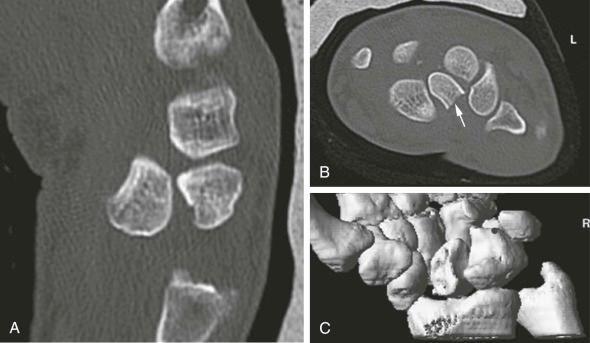
The role of MRI for evaluating carpal ligament injuries is evolving. Recent developments in MR technology such as multichannel phased-array coils and 3-T scanners could dramatically improve the diagnostic performance of MRI of both intrinsic and extrinsic ligament lesions. For optimal visualization of the intrinsic and extrinsic ligaments, a high–field-strength magnet, dedicated wrist coil, and thin image slices are required.
Partial tears and elongated, but intact, ligaments may be visualized with MRI. Partial tear is seen as focal thinning, irregularity, or high signal intensity within a portion of the ligament. Complete tears of a carpal ligament appear as distinct areas of discontinuity within the ligament or complete absence of the ligament ( Fig. 18-9 ). Joint fluid and focal synovitis are sensitive but nonspecific findings of ligament tears. In advanced cases, widening of the joint spaces may be evident.
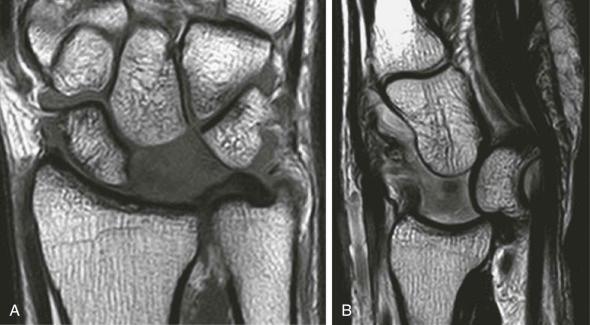
Magnetic resonance arthrography can potentially evaluate the precise location and magnitude of any proximal carpal row intrinsic ligamentous defect and differentiate those lesions that may involve only the central membranous portion. Central lesions that may have a degenerative origin can be painful without indicating instability. MR arthrography increases sensitivity over MRI, especially in subtle injuries. Partial tears may show contrast leak or imbibition into a portion of an injured ligament, and MR arthrography outlines better morphologic alterations or stretching.
MR arthrography may also depict dysfunctional healed ligaments and detect peripheral ligament avulsions more accurately when the ligament has not lost its normal morphology. The latter may be evident clinically but difficult to document with conventional MRI. In complete tears, MR arthrography shows contrast material communication between carpal compartments.
Dorsal and volar extrinsic ligament tears can be evaluated with MR arthrography, but its exact relevancy still has to be defined ( Fig. 18-10 ).

Diagnostic arthroscopy of the wrist is actually the definitive diagnostic study for wrists with suspected carpal instability, including radiocarpal and midcarpal joint evaluation. The arthroscopic findings in carpal instabilities depend on the ligament involved: excessive movement among the bones and synovitis in the area are clues for diagnosis. Arthroscopy is very helpful for ruling out associated osteochondral injuries.
The principal differential diagnosis of wrist instability is congenital wrist hyperlaxity. In such patients, marked carpal malalignment can be present despite minimal or complete absence of symptoms. These patients do not require surgical treatment.
There is no single treatment for carpal instability. The treatment is based on six basic criteria: chronicity (healing potential of the ligaments involved); constancy (dynamic or static); etiology (traumatic, congenital, inflammatory); location (site of the major dysfunction); direction of the abnormal rotation and/or translocation of the carpal bones; and pattern of instability (CID, CIND, CIC, or CIA).
Acute ligament injuries with complete intrinsic ligament rupture and overt dissociation should be treated as soon as possible because the ability to heal decreases rapidly. Repairs can become impossible after 6 weeks. Ligament reinsertion and repair is performed with transosseous stitching or mini bone anchors. Nonstabilizing acute injuries respond to simple immobilization for 4 to 6 weeks, if minor, but require percutaneous Kirschner wiring if the injury is moderate to severe.
Chronic injuries are best currently managed through a tendon graft reconstruction of the ligament instead of arthrodesis, for which prognosis is poorer and the nonunion rate is higher.
Injuries to the ulnar collateral ligament of the thumb metacarpophalangeal (MCP) joint are common in contact sports and skiing.
This lesion was originally noted in Scottish gamekeepers who developed a chronic ligamentous strain or “gamekeeper's thumb” induced by repetitive stress from the method used to kill rabbits. This type of injury is now most commonly associated with skiing and known as “skier's thumb.”
The injuries of the radial collateral ligament of the thumb MCP joint are much less common than ulnar collateral ligament injuries. They account for no more than 30% of all collateral ligament injuries.
The MCP joint of the thumb is a condylar-type articulation that allows motion primarily in the flexion-extension axis and also some degree of rotation. The MCP joint of the thumb is stabilized by the radial and ulnar collateral ligaments, the volar plate, the extensor tendons and their dorsal reinforcements, and the flexor tendon and sheaths including pulley systems, as well as the thenar muscles including the adductor pollicis muscle and its aponeurosis.
Injury to the ulnar collateral ligament is caused by hyperabduction of the MCP joint accompanied by varying degrees of hyperextension (see ![]() ). It is often produced after a fall when skiing with the thumb or the pole planted into the snow. Rupture of the ulnar collateral ligament may be total or partial and usually takes place at its phalangeal point of insertion, but the rupture can also appear at its metacarpal insertion or in its midsubstance. It may be accompanied by an avulsion fracture of the proximal phalanx. The rupture of the thumb ulnar collateral ligament can be an isolated lesion or occur in combination with other joint structures, such as the volar plate or dorsal capsule. When the ligament ruptures distally, retraction may be associated with the interposition of the adductor pollicis aponeurosis with the torn ulnar collateral ligament lying superficially at the proximal end of the aponeurosis ( Fig. 18-11 ). This injury, called a Stener lesion, precludes successful primary healing, resulting in long-term morbidity. Associated compromise of neighboring structures may produce loss of pinch and grasp strength. Ultimately, the injury may culminate in chronic pain and osteoarthritis.
). It is often produced after a fall when skiing with the thumb or the pole planted into the snow. Rupture of the ulnar collateral ligament may be total or partial and usually takes place at its phalangeal point of insertion, but the rupture can also appear at its metacarpal insertion or in its midsubstance. It may be accompanied by an avulsion fracture of the proximal phalanx. The rupture of the thumb ulnar collateral ligament can be an isolated lesion or occur in combination with other joint structures, such as the volar plate or dorsal capsule. When the ligament ruptures distally, retraction may be associated with the interposition of the adductor pollicis aponeurosis with the torn ulnar collateral ligament lying superficially at the proximal end of the aponeurosis ( Fig. 18-11 ). This injury, called a Stener lesion, precludes successful primary healing, resulting in long-term morbidity. Associated compromise of neighboring structures may produce loss of pinch and grasp strength. Ultimately, the injury may culminate in chronic pain and osteoarthritis.
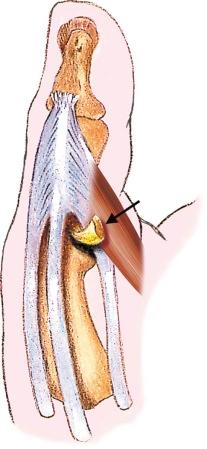
The mechanism of injury of the radial collateral ligament of the thumb is forceful adduction of the thumb in any position. Disruption of the radial collateral ligament is prone to producing a rapid pathologic sequence of joint instability, with progressive ulnar and volar subluxation and, ultimately, degenerative joint disease.
At physical examination, a complete ulnar collateral ligament tear induces the appearance of a palpable mass in the ulnar aspect of the joint and instability to radial stress, reaching an angle of 30 degrees or higher when compared with the contralateral thumb. Nevertheless, it may be difficult to differentiate between a nondisplaced ulnar collateral ligament tear and a Stener lesion in the acute setting because of overlying soft tissue edema and hematoma.
Patients with a suspected ulnar collateral ligament injury should undergo radiographic evaluation (posteroanterior and lateral views) before stressing the joint, to rule out an associated avulsion fracture from the base of the proximal phalanx. Displaced avulsion fractures or any fracture involving 25% or more of the MCP joint surface requires surgical treatment and should not be manipulated. However, avulsion fragments are rarely seen on radiographs (12% of injuries). In the absence of an avulsion fracture, findings on plain films are usually normal. Degenerative joint changes may be seen years later after the initial insult or with chronic injury. A volar mild subluxation of the MCP joint in the lateral radiograph of the first digit suggests a tear involving the dorsal capsule and the volar plate, indicating probable ulnar collateral ligament rupture and instability.
If a fracture has been ruled out, abduction stress views of the thumb are frequently required. More than 30 degrees of stressed radial deviation and more than 20 degrees of difference compared with the uninjured side indicate complete ligamentous disruption. However, results of such radiographs are often difficult to interpret. Furthermore, there is concern that stress tests may potentially be detrimental to patient care by transforming nonsurgical injuries into surgical ones.
Categorization of the tears into surgical and nonsurgical abnormalities is crucial and cannot always be accomplished with radiography.
Ultrasonography allows direct visualization of the collateral ligaments and their surrounding structures. It may allow accurate diagnosis of the complete spectrum of ulnar collateral ligament injuries, including distention, partial tear, complete tear, and Stener lesion. Furthermore, other disorders such as tenosynovitis, tendon tears, and articular pathologic conditions can involve the thumb and thenar region and may also be diagnosed with ultrasonography. A dynamic stress study can be performed (see eFig. 18-4 ), but valgus and varus stress tests are not recommended owing to concern over aggravating an injury.
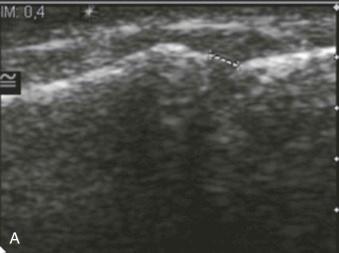
Ultrasonography has proven to be a valuable aid to therapeutic approach. The positive predictive value for tears of the ulnar collateral ligament is higher with ultrasonography (94%) than with clinical examination (80%).
The radial collateral ligament can be elongated, ruptured, or associated with bone avulsion. The ultrasound characteristics of tears of this ligament are similar to those of ulnar collateral ligament tears, with the exception of complications such as Stener lesions, which do not occur because of anatomic differences.
Computed tomography is not useful in isolated injuries of the collateral ligaments. CT is indicated in the case of complex fracture-dislocations of the MCP joint of the thumb to define the degree of comminution within a fracture as well as suspected impaction of the articular surface.
Become a Clinical Tree membership for Full access and enjoy Unlimited articles
If you are a member. Log in here